Tăuții Măgherăuş - Winner 2019
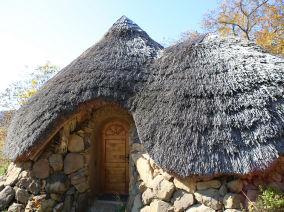
Winner in the ‘Health and wellbeing tourism’ category
The town of Tăuții Măgherăuş, with the belonging localities Băița, Nistru, Bozânta Mare, BuSag, Merisor and Ulmoasa is located in the west of Maramureș County, specifically in the Baia Mare Depression, which is in the beautiful ethnographic region ‘Chioar Land’.
Tautii Măgherăuș is the right place for relaxation and health, with several offers like outdoor activities, hiking trails, hypo-therapy, spa facilities.
What makes Tăuții Măgherăuş special
What do you choose: nature and health or elegance and style? In Tautii Magheraus you can find both. A small town with a wide range of choices for everybody. Add the unique Maramureș style and the unforgettable holiday is guaranteed.
Health and wellbeing tourism
Tăuții Măgherăuș offers health and wellbeing tourism, based on outdoor activities in nature, hypo-therapy, healthy food, authentic traditions and spa centre with various facilities: indoor and outdoor swimming pools, water glides, dry, wet, infrared saunas, Jacuzzi, salt water pools, massage, kineto-therapy, water fitness. There are biking and hiking trails, with some mountain trails leading to Pietroasa Peak (1.201m and part of the volcanic mountain Oas-Gutai-Tibles). Once there, gaze out over endless views covering the Depression of Maramures County, and if the weather is favorable, over Ignis Mountains, Tibles Mountains and even Rodna Mountains. In the summer, you can also go rock climbing on the volcanic Tiganu Peak, a volcanic rock.
Maramureș County is known for its authentic traditional lifestyle, where locals practice agriculture, farming, beekeeping, traditional crafts. In keeping with its sustainability goals, Tăuții Măgherăuș, implemented several projects with the help of European funds. These include converting unused lands into green areas to improving the quality of life of citizens, reducing carbon footprint by purchasing hybrid eco-friendly/environmentally friendly buses, and creating bike paths in certain areas of town.
Visit Ulmoasa, a mountain village in the heart of the forest at the end of a picturesque valley. In this oasis of tranquillity in wild nature, you can admire the traditional houses of the inhabitants, enjoy the fresh air, and experience a sky so close that it feels like you can reach out and touch the stars at night. With the creation of Ulmu Base, the town encourages an ecological lifestyle. There, you can stay in a permaculture didactic natural cottage, while enjoying healthy local organic food, disconnecting from modern life (there is no cell phone signal and no traffic), and attend trainings about an ecological lifestyle.
Sightseeing tips
- Nistru lake, surrounded by forest with cottages, hostels, campsites, as well as marked hiking trails to Hotarului Stone, Soimului Stone and the peak of Cicarlau. Get a guide and explore one of the old mines in the area dating back to before the 1700s.
- Equine-assisted therapy facilities including horse riding courses, hypo therapy (with qualified personnel), horseback riding, horseback riding camps, trainings and hiking trails. Hypo-therapy or horse riding for therapeutic purposes has proven results as adjuvant therapy for a wide range of mental health issues.
- The Traditions Museum,the 300 years old peasant household in the traditional wooden house stuck with clay with three rooms: cork, sawdust and barn. Inside there is a collection of traditional objects and tools from Măgherăuş area with over 300 exhibits.
More information
- The official Tăuții Măgherăuş website
- EDEN video about Tăuții Măgherăuş - Winner 2019
- EDEN contact for Tăuții Măgherăuş: betty_bihari
 yahoo [dot] com (betty_bihari[at]yahoo[dot]com)
yahoo [dot] com (betty_bihari[at]yahoo[dot]com)
Suceava City - Winner 2017

Winner in the Cultural Tourism category
The City of Suceava is located in North Eastern Romania and has contributed to the consolidation of the Romanian culture. Testimonies are Suceava Fortress, the churches and monasteries built by the ruling princes of Moldavia, the monuments of Armenian, Austrian, Jewish architecture, the Bucovina Village Museum and the History Museum.
The inhabitants of Suceava are warm and hospitable people, eager to share the beauty and the greatness of the sights that are part of their cultural and spiritual legacy.
What makes Suceava City special?
The city of Suceava, the county’s residence, is one of the oldest and most important settlements of Romania. It has an exceptionally intriguing historical and cultural story. For almost 2 centuries Suceava was the capital of Moldavia and the first location of the Metropolitan Church. Here Romanians, Germans, Ukrainians, Poles, Armenians, Jews, Czechs coexisted in peace. The city has the perfect blend of tradition, history, religion, spirituality and modernism. It is the gateway to Bucovina. There are many tourist attractions, recreational and leisure facilities, accessible to all. The people are friendly and hospitable. Because of all this, beyond cultural and spiritual aspects, Suceava offers memorable feelings and experiences.
Cultural tourism
Suceava is an excellent destination from a cultural point of view. It has a wide range of 84 cultural heritage sites in total. These include art monuments and architectural ensembles, religious monuments, archaeological remains, a UNESCO heritage site, and museums.
The authenticity of the exhibits displays the richness, uniqueness and heritage value of the collections. Some of the permanent monuments and exhibitions are unique nationally or internationally. Examples are the relics of St. John at ‘St. George’ Church of St. John the New Monastery, the princely grave of Mirăuţi Church, the sound and night light show at Suceava Fortress, the odour of the History Museum, and the customs and traditions presented in the Bucovina Village Museum.
Several annual events present a variety of local traditions and customs related to religious holidays, handicrafts and crafts, folk dance, folk songs and dances, and Bucovina cuisine.
Sightseeing tips
In Suceava city there are several ‘must see’ landmarks, they include:
- ‘St. George’ Church of St. John the New Monastery (UNESCO Monument)
- The Museum of Natural Sciences
- Mirăuţi Church where the rulers of Moldavia were crowned prince
Out of the many important festivals, make sure to see one of the following:
- Easter in Bucovina
- The pilgrimage to St. John the New Monastery
- Stephan the Great’s Medieval Art Festival
- Bucovina Rock Castle
More information
- Suceava City website (only in RO)
- EDEN video about Suceava City - Winner 2017
- EDEN contact for Suceava City: infoturism
 cjsuceava [dot] ro (infoturism[at]cjsuceava[dot]ro)
cjsuceava [dot] ro (infoturism[at]cjsuceava[dot]ro)
Marginimea Sibiului - Winner 2015
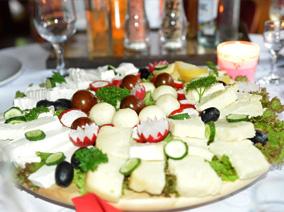
Winner in the Tourism and Local Gastronomy category
Marginimea Sibiului has always been known in Romania as the land of sheep, cheeses and meat delicacies. Its traditional products reflect the richness of the land but also the region’s cultural diversity.
Local gastronomy
When here, try the 'telemea', fresh cheese made of local sheep milk. Cheeses of Marginimea Sibiului are an important part of this region’s culinary and cultural tradition, and its diversity comes from specific production techniques. In the alpine pastures of Marginimea Sibiului the local shepherds continue to use ancestral recipes to produce various sheep cheese products such as 'telemea', 'urda' and 'cas'.
All year long visitors can take part in various festivals and activities to taste local products made by local farmers. Markets and fairs provide the opportunity to taste and buy products directly from the small producers.
The touristic potential of Marginimea Sibiului is recognized both nationally an internationally for its unique ethnographic, cultural, architectural and historical heritage. It has also won the Golden Apple Award of World Federation of Travel Journalists and Writers (2009).
Highlights
The Cheese and Brandy Festival in Rasinari (Festivalul Branzei si al Tuicii). The Cheese and Tuica Festival in Rasinari takes place in the last week of August every year. The festival is a great opportunity for travellers to taste delicious local products and listen to traditional folk music. The event is perfect for those interested in both culinary tradition and local culture, and is situated in a beautiful mountain area covered with forest. The festival reached its 12th edition in 2015.
Tasting sheep cheese in rural guest houses. Having a lunch or dinner in a guest house in Marginimea Sibiului is a great opportunity to discover and taste cheeses and specific shepherd dishes and get acquainted with the lifestyle and customs of the inhabitants of this region.
The Sheep Cheese Route. The Sheep Cheese Route provides an excellent opportunity for discovering the pastoral world of Marginimea Sibiului, with its picturesque settlements and calm lifestyle. Due to continuous shepherding and transhumance, the 18 villages connected to the route have succeeded in keeping their strong local identity. Following the Sheep Cheese Route interested visitors can discover traditional art, lifestyle and customs, to taste cheese and other specialty dishes.
Sightseeing tips
- The Ethnographic Museum of Rasinari where one can discover traditional tools used by shepherds for making cheese
- The Icon Glass Museum in Sibiel
- the ruins of an Dacian fortress in Tilisca
- a wooden church in Poiana Sibiului
- The Museum of Local Culture in Saliste
- The Morariu Jina Collection of Pastoral Objects
More information
- The official website of Marginimea Sibiului
- EDEN video about Marginimea Sibiului
- EDEN contact for Marginimea Sibiului: apar [dot] rasinari
 yhaoo [dot] ro (apar[dot]rasinari[at]yhaoo[dot]ro), lungucarmen
yhaoo [dot] ro (apar[dot]rasinari[at]yhaoo[dot]ro), lungucarmen yahoo [dot] com (lungucarmen[at]yahoo[dot]com)
yahoo [dot] com (lungucarmen[at]yahoo[dot]com)
Jurilovca - Winner 2013
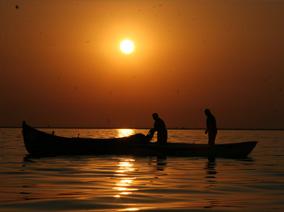
Winner in the Accessible Tourism category
Jurilovca is a town area in the region of Dobrudja, in the far east of Romania. It is situated on the coast of the Black Sea, just south of the Danube delta.
Here, the hospitality of the people blends with the serenity of the blue waters of the Danube and the Black Sea.
The fairy tale landscape is part of the youngest region of Europe, home to a unique biodiversity. It has been declared a biosphere reserve and listed as a UNESCO World Natural Heritage Site. It is also protected under the Ramsar Convention regarding wetlands of international importance.
Jurilovca was founded by Lipovans at the beginning of the 19th century. The small village grew and became an important fishing center in Danube Delta area. Traditional houses and old buildings recall the origin of the city.
Accessibility
The area offers numerous possibilities for tourists: the seaside beach at Gura Portitei, the ancient fortress Argamum (Orgame), boat routes in Razelm-Sinoe lake complex, fishing, traditions of Romanian and Lipovan community and other attractive events.
You can discover the region with tours such as the Northern or Southern Circuits of the lagoon, Babadag Forest Circuit, the Monasteries Circuit, and the Razim – Delta Route.
Sightseeing tips
- Enjoy the fresh salt water of Razim – Sinoe lake complex.
- Discover the well preserved traditions of Romanians and Lipovans.
The traditional Lipovan houses are thatch roofed and the facades are painted in white and blue. The traditional bath, built separately from the house itself, looks like a Russian sauna and the bathing act is almost of ceremonial nature, especially before major holidays. - Step into the ancient world in Orgame/Argamum fortress
It was founded in the 7th century BC by the Greeks of Miletus, being the first settlement on the present territory of Romania mentioned in an ancient source. The fortress was inhabited more than 12 centuries.
More information
- The official website of Jurilovca
- Watch the EDEN video about Jurilovca
- Long version (3 minutes)
- Short version (1 minute)
- EDEN contact for Jurilovca: office
 cjtulsea [dot] ro (office[at]cjtulsea[dot]ro)
cjtulsea [dot] ro (office[at]cjtulsea[dot]ro)
Alba Iulia - Winner 2011
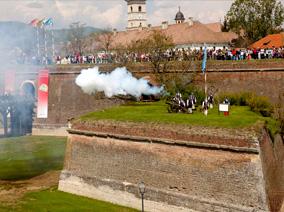
Winner in the Tourism and Regeneration of Physical Sites category
Alba Iulia is a city in the heart of Transylvania, in central Romania. It is situated between the river Mures to the East and the river Ampoi to the North, and offers beauty, cultural heritage, kind people and thousands of local legends.
In the middle of the city lies the largest Vauban Citadel in Romania and the second largest well preserved in Europe. It is the place where on 1 December 1918 Transylvania announced its unification with Romania and where in 1922 Prince Ferdinand was crowned King of Romania.
Regeneration and revival
After years of work and restoration the several sites within the fortified city centre, the Citadel, have been brought back to life, revealing their true value.
A multitude of classical and baroque ornamental patterns enrich the facades of the historic buildings, reflecting the uniqueness of the rehabilitated sites.
The Alba Carolina Citadel was built between 1715 and 1738 in the context of the Habsburg domination in Transylvania. It was constructed on the same place where the Roman Castrum and the Medieval Citadel had existed for centuries.
The Citadel trenches are now for the first time opened to the public, revealing secret passages and new tourist routes. They can be followed by visitors inside the citadel, by foot or by bike, leading them through the heart of the Romanian history.
Sightseeing tips
- Travel back in time through two millenniums on The Route of the Three Fortifications: The Roman Castrum (106 AD), The Medieval Citadel (16th-17th centuries) and Alba Carolina Citadel, a Vauban type fortification (18th century)
- See The Changing of the Guards on Saturdays, when at noon you can admire the canon salutes, a unique show bringing life inside the 300-year-old fortification walls.
- Follow the Route of the 7 Gates of the Citadel.
- See Horea’s Cell - the leader of the Peasants’ Revolt of 1784.
- Explore the 1000-year-old Roman-Catholic Cathedral, where many Transylvanian rulers were buried!
More information
- The official website of Alba Iulia
- Watch the EDEN video about Alba Iulia
- Long version (3 minutes)
- Short version (1 minute)
- EDEN contact for Alba Iulia: marilena [dot] seemann
 hotmail [dot] com (marilena[dot]seemann[at]hotmail[dot]com)
hotmail [dot] com (marilena[dot]seemann[at]hotmail[dot]com)
Geoagiu Bai - Winner 2010
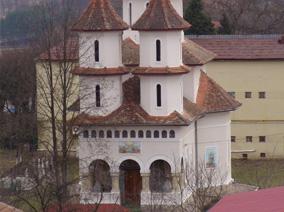
Winner in the Aquatic Tourism category
Geoagiu Bai is a small spa village hidden in the heart of the historical region of Transylvania.
Picturesque mountains and a rich river network surrounds the area, featuring the Homorod, Geoagiu and Mures rivers. The locals call the resort the ‘gift of the mountains’, referring to the mineral richness of the soils and the curative properties of the thermal springs.
Today, the resort features various comfortable vantage points from where you can marvel at the magnificent scenery and soak up the tranquility of the setting. Apart from the beauty with which nature has blessed the region, the refreshing climate with mild winters and pleasant summers allows the resort to be open to visitors all year long.
What makes Geoagiu Bai special?
Geoagiu Bai has something for everybody as it is the perfect location to get active or simply unwind in the extensive and impressive wellness and spa facilities.
Those in need of complete relaxation can recharge their batteries through aero-therapy, hot mineral water baths, thermal mud or herb treatments. With their rich history and heritage, the springs are now one of the most important assets to the region. The locals believe the springs are a blessing from Bendis, the Dacian goddess, to keep their bodies and souls young.
Don't miss...
- the Romans’ Hill with its old springs, used by the Romans in old times
- the Roman Castrum, 8km from Geoagiu, the headquarters of various Roman armies
- the impressive Clocota Waterfall and the magnificent Cold Spring Fountain.
More information
- The official website of Geoagiu Bai
- Watch the EDEN video about Geoagiu Bai
- Long version (3 minutes)
- Short version (1 minute)
- EDEN contact for Geoagiu Bai: adriana_marcu
 yahoo [dot] com (adriana_marcu[at]yahoo[dot]com), primaria
yahoo [dot] com (adriana_marcu[at]yahoo[dot]com), primaria geoagiu [dot] ro (primaria[at]geoagiu[dot]ro)
geoagiu [dot] ro (primaria[at]geoagiu[dot]ro)
Apuseni Natural Park - Winner 2009

Winner in the Tourism and Protected Areas category
Apuseni Natural park is a protected natural area in the northwest of Romania.
With over 1,500 caves located in the park, Apuseni is an explorer's paradise. Hodobana, a massive underground labyrinth that runs more than 21km, is a 'must-see' attraction, as is the Zgurasti Cave, which shelters a spectacular underground lake. There is also the Valea Rea, which is one of the world's most significant caves, containing over 35 different types of minerals.
Another unique phenomenon in the park's landscape is the Groapa Ruginoasa. This colossal ravine has a diameter of about 450 meters and is over 100 metres deep. It was formed by water erosion that cut through the layers of sandstone and red-violet clays.
Apuseni is also home to several alpine sports. Hiking, snowshoeing, and skiing are just a few of the many sports that draw visitors to the area.
What makes Apuseni Natural Park special?
Due to the ever-changing mountain climates, the Apuseni Natural Park never sits still. The region is constantly evolving, with peat bogs emerging in the higher altitudes. The park is also home to over 1,550 different plant species. Spruce forests fill the mountain sides, while wild cherries and black walnuts grow in the meadows.
One of the most extraordinary places in the park is the Padis-Cetatile Ponorului Karst visitor area. It is an area comprised of steep rock walls, wild running water and deep caves.
Recently, carnivorous wildlife previously unknown to science, was discovered in some of the mountains' caves. These discoveries, combined with the already vast numbers of bear, lynx and wolves, make the region a truly remarkable habitat for wildlife.
Tourism continues to steadily grow in the region, and the Apuseni Natural Park has been able to meet this challenge. Developing tourist areas like Vladeasa and Albac offer top-notch accommodations and easy access to the park's attractions.
Having four distinct seasons is also a plus to the region. Tourism is spread out evenly through the year, allowing programs to be implemented to ensure the rehabilitation of the park's hiking and skiing trails. Romania has also reached out to other countries to discuss new and evolving environmental issues and measures. Apuseni Natural Park is a special place and the government plans on keeping it this way.
What to look for in...
- spring: Water rushing down melting mountain tops
- summer: Trekkers winding their way down deep caverns
- autunm: Leaves changing colors as the days grow shorter
- winter: Extreme skiers in search of untouched powder
Sightseeing tips
- Take a canoe trip through breathtaking canyons.
- Spend a summer afternoon at a mountain festival.
- Go rock climbing up limestone walls.
More information
- The official website of Apuseni Natural Park
- Watch the EDEN video about Apuseni Natural Park:
- Long version (3 minutes)
- Short version (1 minute)
- EDEN contact for Apuseni Natural Park: alinmos
 parcapuseni [dot] ro (alinmos[at]parcapuseni[dot]ro)
parcapuseni [dot] ro (alinmos[at]parcapuseni[dot]ro)
Horezu Depression - Winner 2008
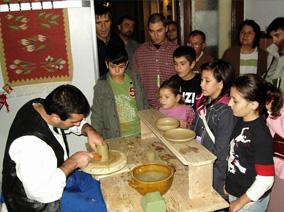
Winner in the Tourism and Local Intangible Heritage Category
The Horezu Depression combines five localities, namely Horezu town and its adjacent main villages, Costesti, Maldaresti, Vaideeni and Slatioara. It is located at the foot of the Capatanii mountains in the sub-Carpathian area. Horezu is at the heart of the valley and is characterised by a community united in its linguistic, cultural and traditional features.
The valley has an exceptional cultural and natural patrimony which the area benefits from. From the tourist’s point of view, the valley is characterised by many peculiarities which grant this destination individuality and uniqueness. There are numerous natural monuments and as many as 93 cultural and historical monuments, enlisted by the Ministry of Culture.
What makes the Horezu Depression special?
The area’s natural geographic environment consists of a mountainous area covering nearly two thirds of its surface, with woods, pastures, hay fields and orchards. The Capatanii mountains offers the highest peaks such as Ursu (2,124m) and Cosana (2,011m).
The region is criss-crossed with many brooks – Costesti, Bistrita, Bistricioara, Horezu, Ramesti, Luncavecior, Luncavat, Recea, Marita and Cerna. Most of these brooks cross the limestone streak at the southern end of the Capatanii. In the Buila-Vanturarita massif, the water has left its mark on the land: karst relief made of impressive gorges (Bistritaand Pietreni gorges - particularly wild) and caves (the Bat’s cave).
The climate differs depending on the relief and altitude. The temperate and Mediterranean influenced climate of the valley contrasts with the mountainous area’s snow that lasts over 180 days a year and offers an extended skiable domain such as Zmeuretu, Govora and Valeanu. The flora develops according to the geographic features of the region – coniferous forests and orchards cover the hills.
An enriching walk
Orthodox Romanian heritage and culture marks the region. The Hurez monastery, a UNESCO monument, is one of the region’s symbols. The diversity of the natural surroundings and historical buildings in the area is astounding and offers a wide array of possibilities to tourists.
Among other religious monuments, the 500-year-old Bistrita Monastery housed the first printing press in Wallachia, and the first book ever to be printed on Romanian land in the 16th century. The Maldaresti fortified houses (Cule) are perfectly preserved fortified dwellings that served for defence during the medieval period. They are also rare sights of ethnography and folk art that can only be found in some localities.
The therapeutic properties of the mineral springs in the Costesti village have been proved over time, and have a treatment base in the Costesti baths and balneoclimatic spa. The gorges of the Bistrita, Costesti and Pietreni are Romania’s narrowest and most impressive limestone gorges.
A visit to Pestera Liliecilor, the bat caves, can be an interesting affair. The Trovanti museum in Costesti is a natural reserve strewn with huge gritstone rock formations that are of scientific and tourist interest due to their dimensions and zoomorphic aspect.
Traditional assets
The Horezu enamelled pottery – unique to Romania through its chromatics and floral motives – is emblematic of the region and are known all over the world. These objects preserve the local tradition and display Byzantine influences that have turned the craft into a brand for the Horezu valley. Traditional tools such as the potter’s wheel, the jay, the horn or the oven, and decorating elements such as the stylized flowers, the spirals, the garlands or the dots, as well as the 'Cocos de Hurez' (the Hurez cock) highlight Horezu pottery’s uniqueness.
Elements of material and immaterial ethno-culture are the legacy of two traditional cultures of mountainous areas: Oltenia and Marginimea Sibiului Surroundings (situated in the north of Capatanii Mountains). Here, the inhabitants have lived for hundreds of years, taking part in the ancient occupation of shepherding and to the phenomenon of 'transhumance' (moving sheep from mountain to plain and vice versa and all the rites that this phenomenon involves). These elements, through their artistic and touristic value, make the area unique.
Shepherds long influenced the regional cuisine, bringing together milk-based products ('jintita', 'urda', 'balmos'), and lamb and mutton-based products.
Several villages preserve traditional crafts and folklore – traditional costumes, weaving, embroidery, as well as the making of sheepskin coats, artistic woodwork, wool processing, architecture. Fairs and cultural events with choirs, whistle-players and folk dancers emphasise this ethno-cultural richness.
More information
- The official website of the Horezu Depression
- Watch the EDEN video about the Horezu Depression:
- Long version (3 minutes)
- Short version (1 minute)
- EDEN contact for the Horezu Depression: alinmos
 parcapuseni [dot] ro ( )dezvoltare
parcapuseni [dot] ro ( )dezvoltare mdrt [dot] ro (dezvoltare[at]mdrt[dot]ro) alinmos
mdrt [dot] ro (dezvoltare[at]mdrt[dot]ro) alinmos parcapuseni [dot] ro ( or ) promovare
parcapuseni [dot] ro ( or ) promovare mturism [dot] ro (promovare[at]mturism[dot]ro)
mturism [dot] ro (promovare[at]mturism[dot]ro)
Buzău Land - Winner 2007
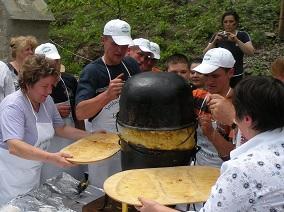
Winner in the Best Emerging European Rural Destination of Excellence category
Buzău Land lies in the South-East part of Romania, in Buzau County, at the crossroads of the three Romanian historical provinces, Moldavia, Transylvania and Wallachia.
The diverse forms of relief are displayed in steps – mountains, hills, depressions – creating an outstanding landscape, enriched by its people, who are happy to welcome guests and to share with them the treasures of a genuine rural life, kept carefully along the centuries.
4 communes in this area: Berca, Chiojdu, Gura Teghii and Mânzăleşti – have been selected as part of 'The most beautiful villages in Romania'.
A wide range of activities
The boarding houses in the area organize trips in the surrounding area, where tourists can angle, pick forest fruit, mushrooms, herbs, aromatic plants or ingredients for preparation of different foods. 'The Truffle Hunt' and cooking workshops with local products and truffles is another experience one can enjoy in Buzău Land. Also, at the end of the autumn, at harvest time, tourists can take part to grapes gathering and wine and plum brandy preparation after a traditional recipe.
In the village of Varlaam, whey therapy, a programme for body rejuvenation unique in Romania, promotes local products such as whey and the benefits of natural herbs in the area of Penteleu Mountains. It proposes an anti stress therapy in hay filled rooms.
The gastronomy of the place is rich, bearing the scents of the place. In a patriarchal atmosphere, visitors can taste traditional products like: cheese, green cheese and 'bulz' from Varlaam (a special dish made of cheese and pollenta), milky soup with greens, home made butter, sour milk in earth jug, smoked trout in fir tree bark, Gura Teghii brandy, sweet and perfumed wine – 'Tamâioasa' prepared at Pietroasele, Buzău onion, Pleşcoi sausages, Buzău autumn cabbage, Buzău pretzels.
For ethno and folklore admirers, local craftsmen can perform demonstrations of egg painting, old traditional shoes (opinci) making and traditional folk clothing sowing. In Colţi area (Piatra Corbului) tourists can see the place where amber stones used to be extracted and also can watch amber processing at a local manufacturer.
Besides the rural tourism attractions there are other exciting things to see in Buzău Land: the Amber Museum, muddy volcanoes, cave settlements, wooden churches, monasteries, mineral water resources, protected areas. Activities like mountain biking, bouldering, horse riding, hiking, bathing or rafting, also enrich the offer of the destination.
More information
- Visit the official Website for Buzău County (only in RO)
- EDEN contact for Buzău Land: birouturismbuzau
 cjbuzau [dot] ro (birouturismbuzau[at]cjbuzau[dot]ro)
cjbuzau [dot] ro (birouturismbuzau[at]cjbuzau[dot]ro)
